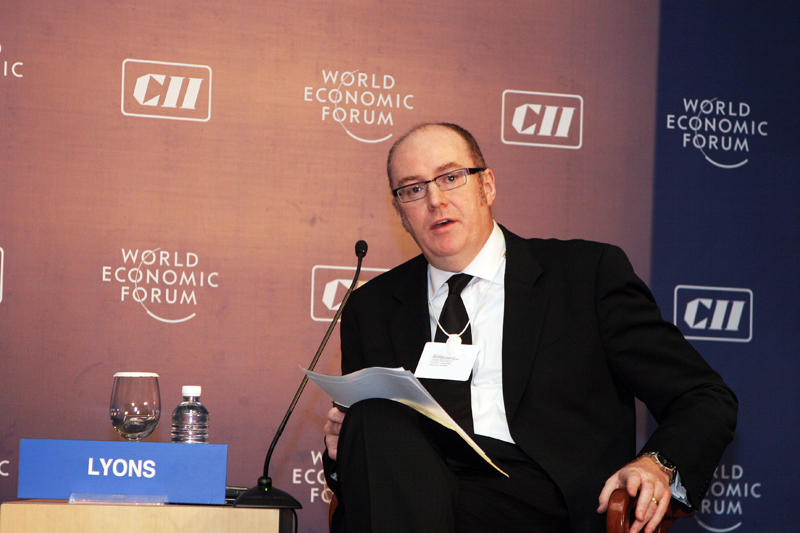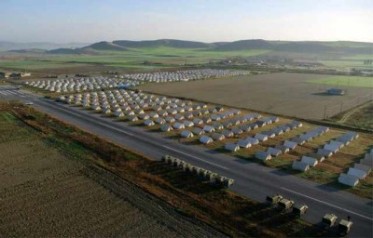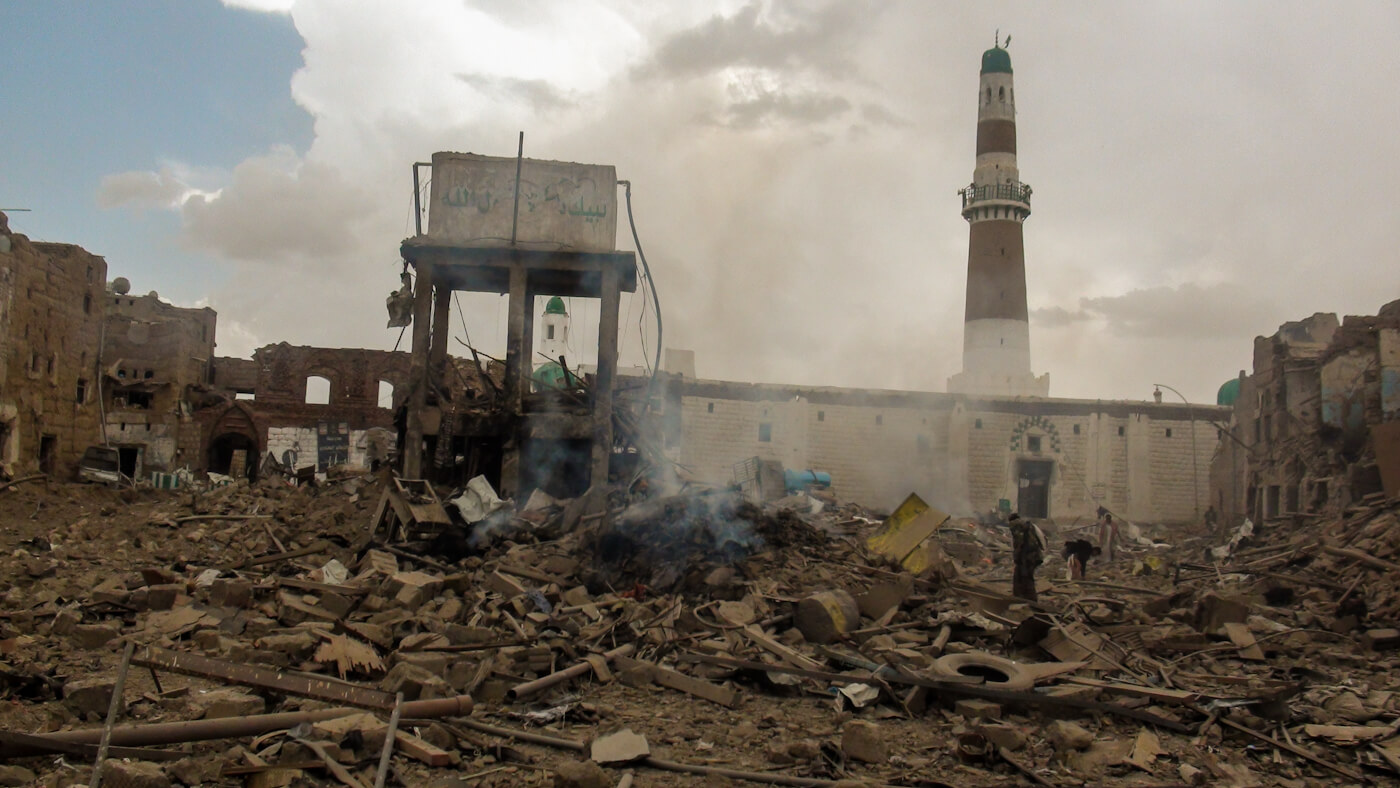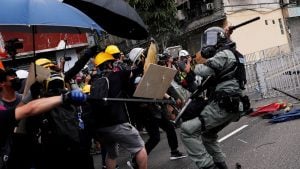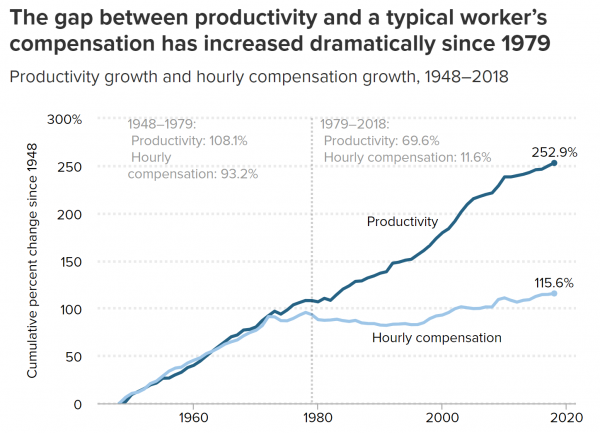The destruction of the Amazon jungles by right-wing Brazilian president Jair Bolsonaro threatens to end our civilization and to condemn the next generation to death and destruction. This is a truly existential moment for us, to use the hackneyed term employed in the media so frequently that most people forget its significance. But as the Amazon burns, due to fires set by those seeking to make short-term profits for the few off of the jungles that purify the atmosphere shared by all of humanity, we are made aware of how completely defenseless we are.
The United Nations can make statements, famed intellectuals can write editorials, NGOs can protest in front of Brazilian embassies, and citizens can sign petitions, but we are essentially powerless in the face of a criminal effort to destroy our future.
Some are so married to the idea of solving all problems peacefully through discussion that they cannot imagine real resistance. Or they are so accustomed to opposing demands for regime change that come from right-wing think thanks that they are allergic to the very concept—even when it is necessary for our survival.
But a progressive form of regime change [emanating from the grassroots] is an entirely legitimate thing for concerned citizens to advocate for. Do not forget the thousands of committed youth who went to Spain in the 1930s to fight against Franco’s fascist regime. There was no shame in the word regime change then, nor should there have been. Nor was there any shame in the use of the force of arms to combat the fascistic governments that were set on slaughtering the majority of humanity in a ruthless quest for “living space.”
There can be no mistaking the threat of totalitarian governance and the destruction of the ecosystem and of humanity in the ruthless search for profit. We cannot ignore the pressing need to transform our world and that will require more than signing petitions. It will require us to reinvent global governance, not as a tool for investment bankers and wealthy philanthropists to flatter themselves, but as a means to address the threats of ecological collapse, militarism and the massive concentration of wealth.
It is no mystery why the G7, the G20, the United Nations and other global organizations are entirely powerless to respond to burning of the Amazon, even as scientists describe it as a threat to life on earth that may be the equivalent of a world war.

The radical concentration of wealth has made those global organizations into the play toys of those with money.
And the superrich have somehow convinced themselves that money and technology can save them from the catastrophe that awaits us. That attitude is best summed up by Lt. Gen. Steven L. Kwast, of the recently launched “Space Command” which will bring the war for dominance into low orbit, into a region that should be the shared legacy of all of humanity. Kwast notes,
“There is also a marketplace of opportunity for humans not only to live and thrive in space, but also to have a place to go if there is ever any problem with Earth whether it is from an asteroid, from a disease, or any kind scourge of human nature or of nature that can threaten human life. This is the broad arch of history that we sometimes forget because we have lived in such a cocoon of protection and security for so long that we forget the fact that there is a cycle asteroids and of contagion that can wipe out from the dinosaurs to the human race. And there is nothing you can do about it unless you have a sanctuary you can go to.”
Kwast does not use the word “climate change,” but there can be no doubt that it is what he refers to by a “problem with Earth.” He is selling a delusional fantasy that somehow the control of space will allow some to survive catastrophe. This superficial and thoughtless strategy is typical of the bankruptcy of global governance today and it is leading us towards military conflicts in space, in the Arctic and the Antarctic, and in the oceans which should be a shared commons, not the exclusive property of corporations.
We face an ideological and systemic collapse around the world that is at least as dangerous as that which we face when the United Nations was established in 1942 and that even if Trump and Bolsonaro are not sending millions to death camps yet, their assault on the climate and their embrace of fossil fuels will be far more lethal for humanity than were the German death camps.
We need a vision for a future world that will move beyond this suicidal consumption-driven and military-dominated society and will inspire us to risk everything we have to fight against such dark powers as they tear our world apart.
The United Nations did not suddenly spring into being. It was at the center of the drive to battle against fascist movements which had taken over many nations through force and by ideological struggles, roaming over large swaths of the Earth and threatening to destroy much of humanity. It was a time, that is, not unlike our own.
A small group of intellectuals and political activists risked their lives in all corners of the Earth to fight against totalitarianism, and advocate for internationalism and for peace. Eventually, they joined forces with Russia, China, the United States and Great Britain, and with other exiled governments in London, Washington and Shanghai. There were profound compromises in that process, but together they planned not only for the defeat of the Fascists, but also for a new form of global governance.
Those who had battled against Fascism in the streets of Europe and Asia came together for a brief moment with those who held institutional power and were able to rise above the exploitative systems that had put them in power. The wisdom and the experience of those who had led the struggle was reflected in government policy for a change, and an institution dedicated to true global governance, both inspiring and infinitely practical, was established.
The “United Nations” grew out of the struggle to create a new system for international relations that can be traced back to the Hague Peace Conventions of 1899, 1907 and 1914 (the final one was disrupted by the outbreak of World War I). Those peace conventions codified the principles of international law, proposed, and started to implement global regimes for disarmament, and promulgated humanitarian laws for the conduct of diplomacy, trade and war that included the punishment of war crimes. The tradition of the Hague Peace Conventions, although completely ignored by the media today, was the source of much of what we think of as international law beyond trade policy. That tradition is what we most desperately need today.
The proposals of the Hague Peace Conventions were developed further in the League of Nations after the catastrophe of the First World War, moving the Earth closer to a form of global governance that could counter global governance driven by multinational corporations. This effort culminated in the Kellogg–Briand Pact of 1928 which set up a framework to end war in a systematic, legal and institutional manner.
That effort did not succeed, as we know from the rise of Fascism, but it did not fail entirely either. The Hegelian spiral continued upwards and even in the midst of the chaos of the Second World War, the United Nations took shape, and a small group of intellectuals and activists around the world struggled to push forward with a new model for true governance.
Sadly, the United States, flushed with confidence after its victory in the Second World War, was unable to pass up the temptation to inherit the spoils of the British Empire. By the end of the Korean War, the financial elites with deep ties to London were victorious over those Americans who had taken cause with the global struggle against Fascism. The United States thereafter turned the Soviet Union into a rival, rather than a partner for world peace. The Cold War was born and the United Nations was still born.
But even if the United Nations did not realize its full potential during the Cold War l, it continued to play a critical role defusing crises and proposing solutions to intractable global problems.
The end of political economies focused on a socialist model in Russia and China has profoundly distorted the discourse on policy in the United Nations because the previous pushback on issues of class and capital has vanished. Yet, even after the United Nations’ budget was stripped to the bone during the George W. Bush Administration and United Nations resolutions were ignored as a matter of course, even as American policy drifted further and further away from international law under the Trump administration, the United Nations remained vital as the place to which citizens of the Earth feel that they can appeal for justice and for guidance.
The United Nations, stuffed with retired bureaucrats in cushy jobs, funded (directly and indirectly) by multinational corporations and billionaires, continues to drift away from it moorings. And yet, again and again, we appeal to it to play the role that no other institution can play, and on occasion it stand for the greater good and for ethical policy.
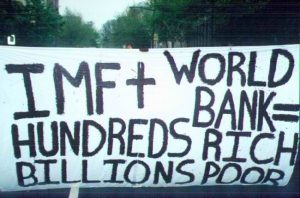
The desire for an agency of global governance accountable to the people, in contrast to numerous secretive and self-interested institutions that dominate global governance such as G7 and the International Monetary Fund, has been enough to keep the United Nations going even through the most difficult of times. The United States, however, never regained the institutional commitment to the United Nations it had under President Franklin Roosevelt.
We are facing political and ideological dangers equal to, or greater than,those that we faced in 1942. We have not yet witnessed anything in this struggle, in this chaos, as horrible as the slaughter of millions by the Nazi armies in Poland, the Soviet Union and China. Nevertheless, the decision of the United States to renounce all arms control treaties, to launch wars of aggression in Iraq, Afghanistan, Syria, Yemen and elsewhere (and to openly prepare for war with Iran, Russia and China) suggest that a conflict on that scale (or greater) is entirely possible.
The complete collapse of arms control policy in the United States, now that right-wing and corporate power has taken complete control of global and national governance, is best embodied by the ideologue and psychopath John Bolton who has opened wide the gates of hell. The United States and Russia now have thousands of nuclear weapons that are thousands of times more powerful than those that destroyed Hiroshima and Nagasaki in 1945.
The threat of war against China made by US vice president John Pence, a fascistic “Christian” leader who has drunk his full at the teat of militarism, suggests that total war is not just something to be experienced vicariously on video games, but quite plausible as American policy. If Trump is not afraid of the catastrophic implications of climate change what makes you think that he is afraid of nuclear war?
The breakdown in global governance cannot be separated from the concentration of wealth. We now see in the mainstream media, on Facebook or Twitter (which is the only media most citizens have access to unless they come from privileged and educated families) that opinions on climate, economics, and geopolitics comes primarily from billionaires like Jeff Bezos, Bill Gates or Michael Bloomberg, or from their shills, and not from individuals with expertise, or with a deep ethical commitment to the common good.
The “Wealth-X World Ultra Wealth Report 2018” reported that 255,810 “ultra high net worth” (UHNW) individuals (people with over $30 million USD in assets) now control $31.5 trillion USD. That amount is greater than the total assets controlled by 80 percent of the Earth’s population, some 5.6 billion people. The increase in the wealth of these UHNW increased by 16.3% between 2016 and 2017, and when the figures are released for this 2018, the rate of increase will most likely be far higher. It is these superrich, and not the United Nations bureaucrats, who call the shots in global governance today.
Don’t reform the United Nations; Transform the United Nations
The current institutional decay of national, regional and international institutions is not theoretical or forthcoming. It is right here, right now. The global liberal order that once we trusted to guide us forward has collapsed, leaving behind a smoking crater wherein investment bankers and their lackeys spar with vicious fascist tribes.
And although those groups may disagree about who gets what part of the spoils, they are working together to burn down the Amazon, and to prepare for war with China and Russia; they are deadly serious and they have no intention of backing down—or even of negotiating.
Don’t bother asking them what they are going to do; ask yourself, what are we going to do?
Such a dangerous and unstable world demands from us nothing less than a global response. “Global” does not refer to shared Facebook postings, but rather a coordinated international effort by committed citizens of the Earth who are at least as well organized as the investment bankers, and ethnic nationalists that we are up against.
This unstable world also demands that we form institutions that go beyond the limited capacity of the United Nations so as to address the single greatest political issue: The Earth is excessively integrated in terms of finance, manufacturing, distribution and consumption but we remain complete strangers when it comes to collaboration between ethical intellectuals and citizens groups. We need a global system that supports,first and foremost,the rational scientific analysis of the causes of the threats that we face, and that oversees the immediate and effective implementation of a massive response for the entire Earth—regardless of borders.
Numerous proposals for United Nations reform have been made over the last six decades. Some, like the Millennium Development Goals, have been partially implemented. Yet the vast majority of the ideas proposed have been left to rot because the United Nations, and the nation states of which it is comprised, are increasingly manipulated by global investment banks and other vested interests who are concerned primarily with their own profits.
The hour is late and the institutional rot is deep. Whether we look at the degeneration of United Nations’ assignments into perks for bureaucrats or the commercialization and the privatization of the policy making process, the UN is no longer able to rise to the critical tasks of preventing world war, ending the unholy concentration of wealth, or reducing the catastrophic warming of our Earth.
The Earth Congress
The current situation is so serious that a laundry list of piecemeal reforms for the United Nations will not do. What we need is a proposal for a massive structural transformation, not a progressive adjustment, that will change the function of the United Nations, and be a shift equivalent to the move from the League of Nations to the United Nations.
We must make the United Nations a bicameral representative institution, vaguely akin to the United States Congress, or to Great Britain’s Parliament, so that it no longer represents the outdated institutions known as nation states, but also represents the citizens of the Earth in a democratic manner. That is to say we must make it function more like a government, but do so by making it directly representative.
Such a move will give the United Nations back the mandate that it had in 1942.
The current United Nations assembly should become the upper house, the equivalent of the Senate in the United States. This upper house, which could keep the title “United Nations,” will offer each nation state a single representative. The current Security Council, however, should be replaced with a speaker elected by all members of the United Nations who works together with permanent and ad hoc committees to address economic, security, welfare and environmental issues for the Earth as a whole.
The majority of the authority in global governance, however, should be transferred to a new legislative body that will serve as the rough equivalent of a lower house, or a “House of Representatives.” The analogy to a lower house is limited, however, because this assembly will play the central role in global governance.
This legislature, hereafter referred to as the “Earth Congress,” will serve as a means of representing the needs and the concerns of the citizens of the Earth at the local level, while at the same time functioning as global institution for the formulation and for the implementation of policies for the entire Earth. It will carry out the global governance function which is currently monopolized by investment banks, multinational corporations and the consulting firms that they support, and then forced upon nation states through corrupt political systems.
The Earth Congress will be directly engaged with citizens around the world, both responding to the actual concerns of local populations and representing their interests and also informing them about global issues in a scientific and rational manner. It will establish a global dialog for the formulation of policy and the policy that it produces will be binding across the entire Earth. It will not be an oppressive world government because it will be far more democratic in nature than most current nation states. Moreover the Earth Congress will provide funding for global action based on an objective assessment of the Earth’s needs. It will not be dependent on the whims of billionaires or the profits of corporations in order to implement its goals.
Although the Earth Congress will draw on the traditions of the League of Nations and of the United Nations, it will go further by taking full advantage of new technologies to facilitate the promotion of true cooperation around the world whether dialog between citizens, joint research between scientists or cooperation on global issues between governments. It will not have a central building where representatives gather, but will rather have its meeting places distributed across the Earth, even as policy is formulated in a centralized manner.
Because the Earth Congress is concerned with democratic governance, education must be a critical part of its mission. Governance is in decline around the world not so much because of corrupt politicians, but because the media and educational organizations on which we depend have declined radically in their quality and therefore most citizens of the Earth are encouraged to respond to gimmicks and fads rather than to engage in rational discourse and objective analysis. The citizens of the Earth are subject to a broad anti-intellectual attack that makes political discourse difficult and ethical governance nearly impossible.
The Earth Congress must offer to citizens around the world the chance to learn about the critical problems that we face and at the same time opportunities to participate in governance at the local level that will be reflected in policy discussions at the global level. Such a process requires a radical restructuring of the value systems promoted by business in the local economy so as to make participation in political discourse a high priority.
The Earth Congress will take the lead in formulating strategies that allow citizens to work together with their peers around the world. Trade will no longer be limited to the import and export of goods monopolized by large corporations in a manner that greatly increases carbons emissions. Rather a truly shared economy will be established in which communities around the world can find like interests and coordinate their own micro-trade and manufacturing cooperatives so as to form a citizen-based global integration that counters the current concentration of capital in the hands of those who dominate trade and finance. Such efforts should not be a sideshow, but rather central to the future of global governance.
The actions of for-profit organizations that seek to obtain short-term benefits through the destruction of the Earth’s resources will be strictly regulated by the Earth Congress. The Earth Congress, funded by a system of local contributions, must serve as a global organization that capable of both assessing impact of current corporate exploitation of resource and of definitively stopping such actions. It will be capable overriding the criminal actions taking place in Brazil today, or creating a long-term plan to wean the Middle East permanently of dependence on petroleum for economic development.
The Earth Congress will regulate, on behalf of the population of the entire Earth, the oceans, the Arctic and the Antarctic, the atmosphere and the satellites and other devices that orbit the Earth, and it will set out transparent and effective regulations to assure that the internet is based entirely on renewable energy, is accessible to all and promotes an open intellectual discourse based on the scientific method.
Policy will be made within the Earth Congress, and not by law firms, or by think tanks, or by consulting firms that lack transparency or accountability. The Earth Congress will be funded by contributions from citizens (which will ultimately be obligatory like taxes) across the Earth. It will employ such an approach because it allows it to create institutions to govern the world that will replace those based on profit today which do not consider the health of society or of the Earth. The Earth Congress will not be allowed to accept questionable forms of support from profit-seeking organizations.
It is better to have a smaller budget and be able to make accurate and objective decisions than to have massive funding that promotes corrupt and dangerous policies.
The Earth Congress, as the primary legislative body of the United Nations, will determine representation according to the population of the entire Earth.
Perhaps one representative can be assigned for every 50 million people (120 representatives for 6 billion people). Some parts of the representation should be determined geographically (to represent regions like Africa or South America) but at the same time, there must be members of the Earth Congress who represent groups who are a significant part of the Earth’s population, but who are too few in number to have direct representation in local government. For example, the extreme poor, or the handicapped, should be granted representatives to reflect their global significance, even though they do not represent a large population in any one country. Such an approach will provide a global democracy to counter the global tyranny of multinational corporations.
The Earth Congress will be responsible for assessing the long-term interests of humanity and of our precious Earth without concern for national boundaries, or for special interests. It will then propose long-term solutions to current challenges and implement them on a global scale.
The Earth Congress must insist on long-term (minimum of 30 years) solutions to the most critical issues facing the Earth and will encourage thoughtful and frank discussions about security concerns such as climate change and immigration that are not driven by a need for symbolic images, but real solutions.
Because it makes long-term policy, the Earth Congress will also provide long-term financing globally that will make solar and wind power, and other organic farming projects readily affordable for citizens of the Earth.
The Earth Congress must move beyond the short-term, case by case, arbitration of economic and political conflicts of interests between nation states that have paralyzed the United Nations. Rather it will plan for the future of humanity in an integrated manner with a focus on the long-term ecological health of the Earth.
Problems such as saving dying oceans, reducing the emissions of dangerous chemicals, countering the spread of deserts and stopping the proliferation of dangerous weapons cannot be addressed by nation states or international organizations that are dependent on the good will of the wealthy.
For the Earth Congress, security will be defined as protecting the Earth and its inhabitants. Its inhabitants are not only humans but also indigenous animal and plant life. It is a basic assumption within this new approach to global governance that no one owns the oceans, the air, or the land and that all modern concepts like “real estate” and extraction are extremely limited in authority. The Earth Congress will strictly regulate fishing, pollution of the air and the water, the destruction of soil and of natural habitats and it will focus on projects to restore the natural environment.
The interaction of experts in the Earth sciences, the environment, agriculture and technology with groups that are deeply engaged with ordinary citizens and with representatives of local governments will create a positive cycle of inquiry, objective analysis, constructive proposals and transparent and global implementation that will usher in a new age for meaningful global governance.
The future of global governance
There is nothing idealistic or unrealistic about this proposal for the meaningful reform of global governance.
We already have a highly integrated system for global governance administrated by investment banks and sovereign wealth funds which use banks of supercomputers to calculate their short-term profits and force through policy at the local, national and international level to support their interests.
The rapid advancement of communication technologies taking place today has already established a form of global governance that overpowers the nation-state, whether we like it or not, whether we know it, or not. Our only choice is to embrace the best of the traditions of moral philosophy and good governance, and to use our creativity and our industriousness so that we can create a better model for global governance, on that addresses in a direct and long-term manner the tremendous challenges of the current age, rather than the short-term profits of the few.
*
Note to readers: please click the share buttons above or below. Forward this article to your email lists. Crosspost on your blog site, internet forums. etc.


